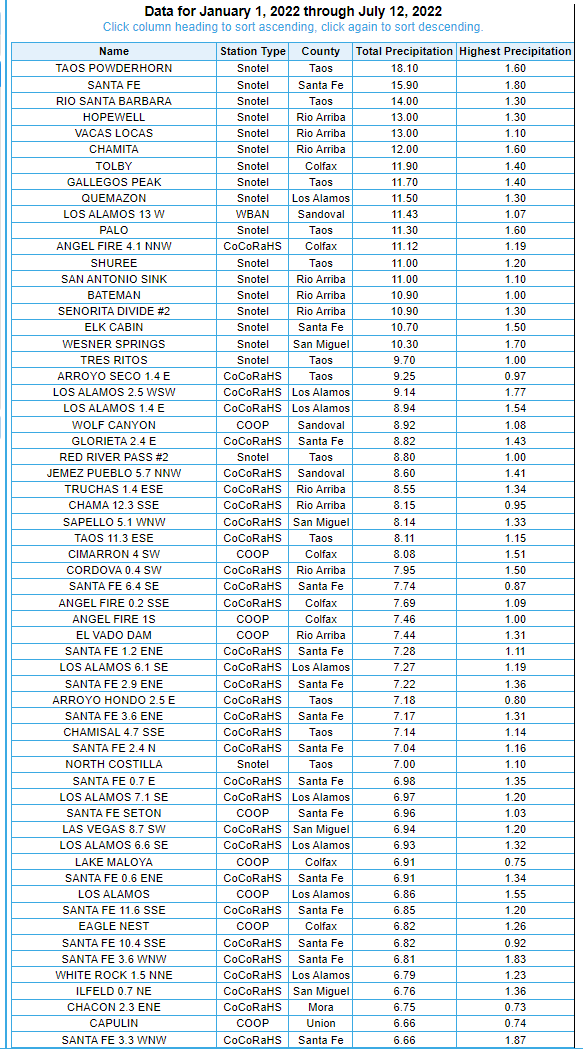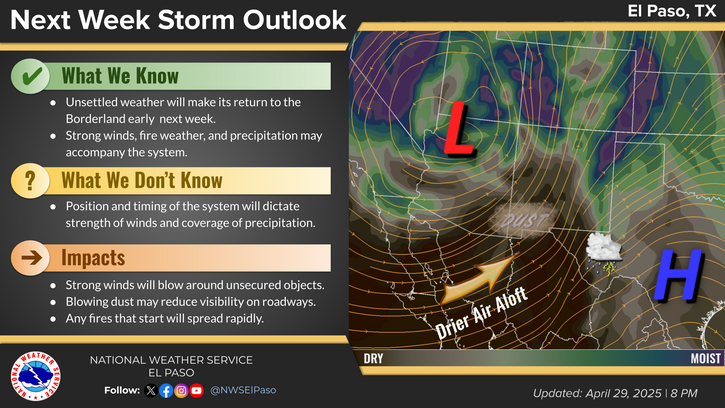SE Plains & Guadalupe Mtn's Forecasts
Sacramento Mtn's Forecasts
My Current Weather
My Daily Climate Summary
Sunday, July 24, 2022
July Rainfall Totals To Date & Number Of Days 100+.
Thursday, July 21, 2022
Shooting Lightning Photos During A Haboob - Carlsbad, NM 7-21-2022.
Just before sunset a nice energetic thunderstorm blew up northeast of Carlsbad and started heading southwest. It missed us here in town but dropped nickel to quarter size hail along with strong winds in Loving 12 miles southeast of us.
Off I go to C-Hill on the west side of town to try and get some lightning shots. This has not been my year for lightning shots. I bought a MIOPS Smart Lightning Trigger for my Nikon D5600. We aren't getting along. I can't get the stupid thing to fire most of the time so back to the drawing board for my research.
Tonight's issues were interesting to say the least. This thunderstorm quickly became severe as it rolled through Loving. Along with the hail and half of an inch of rain it dumped on them it also produced a haboob. Which of course traveled northwest into Carlsbad during my lightning photo session.
I finally gave up on my lightning trigger and shot these three photos the old-fashioned way. Set the camera in manual mode and open the lens. Sadly I spent most of my time fighting with my lightning trigger instead of concentrating on the storm. Of course, the best lightning strikes occurred when I was arguing with the trigger and not paying attention to the storm.
And on top of all of this, I forgot that I grabbed my Go Pro camera and forgot to set up it for some time-lapse shots. I hate technology sometimes especially when chasing. This is why I never really got into live streaming when storm chasing. You end up wasting your time fighting with your cameras, internet connections, etc. Instead of enjoying the beauty of the moment during the storm. And trying not to get killed by the things. Oh yeah, it was still 95º at 8:30 PM when I started shooting so I was watching for rattlesnakes...another distraction.
The blowing dust and sky instrument provided an interesting backdrop for two of my photos along with the city lights.
Live and learn with better luck next time...I hope. Oh yeah, not a drop of rain at our home in town and so my year-to-date rainfall total stands at 2.47" Only about 4 inches below normal. Think rain, pray for rain, wash your vehicles, do rain dances, something. This drought and excessive is beyond old!
Tuesday, July 19, 2022
One Hot July Afternoon.
Blog Updated At 10:10 AM MDT Wed, July 20, 2022.
Artesia Airport AWOS 106º Prvs 104º In 2018.
Alamogordo Airport AWOS 104º Prvs Climate Co-Op Station 102º In 1981, 2018.
Caprock Raws 102º.
Mountain Park Climate Co-Op Station 99º Prvs 92º 1937.
Elk Climate Co-Op 96º Prvs 93º In 2019.
Mayhill Raws 94º.
Sierra Blanca Regional Airport AWOS 90º.
Mescalero Raws 89º.
Cloudcroft Climate Co-Op Station 81º Prvs Record 80º In 1981, 2004.
Friday, July 15, 2022
Stuck With Unrelenting Summer Heat & No Rain.
Synopsis: La Niña is favored to continue through 2022 with the odds for La Niña decreasing into the Northern Hemisphere late summer (60% chance in July-September 2022) before increasing through the Northern Hemisphere fall and early winter 2022 (62-66% chance).
During June, below-average sea surface temperatures (SSTs) weakened across most of the central and eastern equatorial Pacific Ocean with SSTs returning to near-average in the east-central Pacific [Fig. 1], as reflected by the Niño indices, which ranged from -0.4°C to -1.2°C during the past week [Fig. 2]. Subsurface temperatures anomalies averaged between 180°-100°W and 0-300m depth were weakly positive in June [Fig. 3]. Below-average subsurface temperatures persisted near the surface to ~75m depth in the eastern equatorial Pacific Ocean, with above-average temperatures at depth (~100 to 200m) in the western and central Pacific Ocean [Fig. 4]. Low-level easterly wind anomalies prevailed in the western and central equatorial Pacific, while upper-level westerly wind anomalies continued over most of the equatorial Pacific. Convection remained suppressed over the western and central Pacific and enhanced over Indonesia [Fig. 5]. Overall, the coupled ocean-atmosphere system was consistent with La Niña conditions.
The most recent IRI/CPC plume average for the Niño-3.4 SST index now forecasts La Niña to persist into the Northern Hemisphere winter 2022-23 [Fig. 6]. The forecaster consensus also predicts La Niña to persist during the remainder of 2022, with odds for La Niña remaining at 60% or greater through early winter. Lowest odds occur during the next few months with a 60% chance of La Niña and a 39% chance of ENSO-neutral during July-September 2022. Subsequently, chances of La Niña increase slightly during the fall and early winter. In summary, La Niña is favored to continue through 2022 with the odds for La Niña decreasing into the Northern Hemisphere late summer (60% chance in July-September 2022) before increasing through the Northern Hemisphere fall and early winter 2022 (62-66% chance; click CPC/IRI consensus forecast for the chances in each 3-month period).
This discussion is a consolidated effort of the National Oceanic and Atmospheric Administration (NOAA), NOAA's National Weather Service, and their funded institutions. Oceanic and atmospheric conditions are updated weekly on the Climate Prediction Center web site (El Niño/La Niña Current Conditions and Expert Discussions). Additional perspectives and analysis are also available in an ENSO blog. A probabilistic strength forecast is available here. The next ENSO Diagnostics Discussion is scheduled for 11 August 2022.
To receive an e-mail notification when the monthly ENSO Diagnostic Discussions are released, please send an e-mail message to: ncep.list.enso-update@noaa.gov.
Tuesday, July 12, 2022
NM Max Temps & Year-To-Date Rainfall Totals As Of July 11, 2022.
New Mexico
Eddy County
Chaves County Plains & Mtn's
Culberson County
Lea County
Lincoln County
Otero County
Average Daily High/Low Temperatures & Rainfall













































































